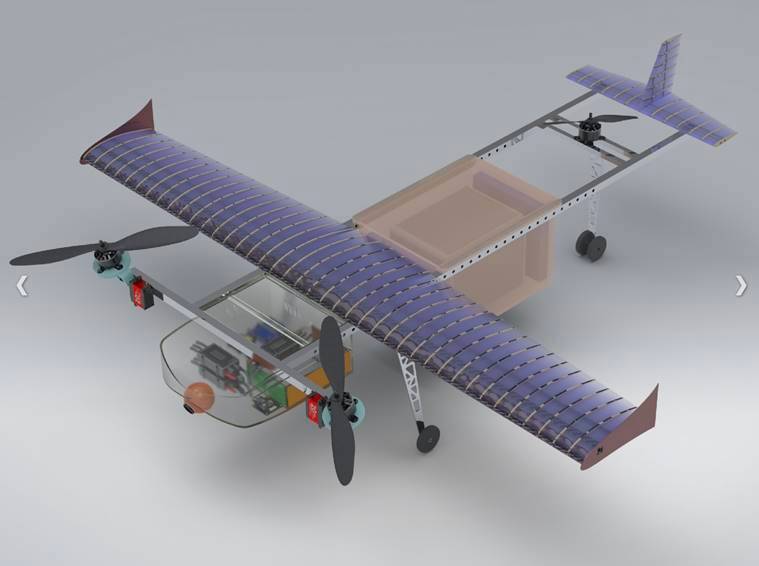
SOURCE: ENS
Drones or unmanned aerial vehicles (UAVs) might be a common sight at weddings in India, but their use cases go beyond videography. Drones hold a lot of promise in several sectors such as agriculture, healthcare, mining, construction, conservation, etc, given their varied use cases. According to an industry report, the market for UAVs in India is expected to touch $885.7 million by 2021. Considering the projected growth there will be a need to produce drones dedicated to different sectors creating opportunities for local manufacturers.
Recently, Dassault Systemes hosted a virtual hackathon titled ‘Drone-a-thon: Propelling Sustainability’, which is aimed at helping students, entrepreneurs, start-ups create the next-generation of drones powered by the company’s 3DExperience platform. This is a cloud-based platform that helps businesses with software solutions.
As part of the Drone-a-thon, 21 of the best ideas were selected and will be given access to the 3DEXPERIENCE platform and incubated with design, modelling and simulation concepts in drone making. Dassault will then shortlist five teams, who were judged by an external jury. Team Terneagle from Punjab Engineering College was declared as the winner of the virtual competition, and got a cash prize, mentorship along with access to 3DEXPERIENCE assets and 3DEXPERIENCE Lab start-up incubation Hubs in Pune, Paris and Boston. The drone designed by Team Terneagle is capable of consumer goods delivery, postal deliveries, food deliveries, healthcare-medical deliveries and even disaster management.
In a conversation with indianexpress.com, Shree Harsha, India Marketing Director, Dassault Systemes talked about the future of drones, and their potential in Indian markets. Here is an edited version of the interaction.
In which sector do you see drone adoption growing in India?
Drones have proven to be among the most promising technologies emerging from the Fourth Industrial Revolution. There is no doubt that the drone industry is on boom growing at a pace of over 40 percent year-on-year. Focusing on recent trends induced by the pandemic, drone adoption is mainly observed in sectors like agriculture, mining, rural healthcare and e-commerce.
We have also observed that drones are largely used in COVID-19 crisis response in India in fumigation and sanitisation of cities and in even in locust control in parts of Northern India
What kind of technology is being seen on drones?
Drones can be fitted with any technology-enabled devices for monitoring, mapping and surveillance. These include cameras, thermal cameras, SONAR systems etc . Drones are still in their infancy, and as material and microcontroller technologies improve, the drones of the future will evolve in ways that may seem almost like science fiction. The most vital parts of a drone’s “nervous system” are its tilt sensors. Combining a mix of gyroscopic sensors and accelerometers, tilt sensors are tied into feedback loops with the drone’s motors.
A drone in flight constantly makes tiny adjustments to motor thrust to remain level, allowing it to recover from air currents and extreme manoeuvres. Some advanced drones can also independently tilt each rotor, allowing the drone to control both the direction and strength of the thrust it gets from each rotor.
Drones can also employ a variety of other sensors to monitor their internal systems and the world around them. Current and voltage sensors help the drone track the energy drawn from its power reserves, helping its pilot know when it is time to land and recharge.
GPS and magnetic sensors aid in navigation by measuring the drone’s location and orientation. Airflow sensors allow drones to detect their airspeed or wind currents, and that information can be fed back into its balancing circuits to make the drone’s flight even more stable.
How can drones help in the agriculture and healthcare sectors? How accurate do you think they can be?
The adoption of UAVs in agriculture or drones can revolutionise the way we prepare for and respond to disasters that affect the livelihoods of vulnerable farmers and the country’s food security. Agriculture drones empower farmers to adapt to specific environments and make mindful choices. The gained data helps regulate crop health, crop treatment, crop scouting, irrigation, and carry out field soil analysis and crop damage assessments. The drone survey helps boost crop yields and minimise time and expenses.
Unmanned Aerial Vehicles are an excellent way to modernise the last mile in medical deliveries and bridge gaps in access. Drones can provide just-in-time resupplies of key medical items, regardless of location. Since some health systems can’t afford to keep cold-chain products such as platelets or blood on-site, drones can ensure these supplies are available on demand. With technology, data stored and premises coverage, drones are expected to deliver accurate and efficient solutions.
How can drones help in disaster management?
Some cities are starting to use drones as a tool for disaster response. During some recent disasters, drones were deployed to help find people that were in need of assistance. They have also been used to create disaster maps and assess damage after events like hurricanes and earthquakes. Using drones, infrared cameras, and AR technology, technology can be used to create heat maps that can help firefighters locate hotspots. These can also help locate people that need rescue, and can survey a building to find where flames are spreading.






